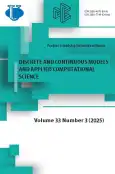Dark matter hypothesis and new possibilities of the Skyrme-Faddeev chiral model
- Autores: Rybakov Y.P.1
-
Afiliações:
- RUDN University
- Edição: Volume 33, Nº 3 (2025)
- Páginas: 299-308
- Seção: Physics and Astronomy
- URL: https://bakhtiniada.ru/2658-4670/article/view/348824
- DOI: https://doi.org/10.22363/2658-4670-2025-33-3-299-308
- EDN: https://elibrary.ru/HHVFRM
- ID: 348824
Citar
Texto integral
Resumo
New possibilities of the 16-spinor realization of the Skyrme-Faddeev chiral model are discussed. Using gauge invariance principle, it is shown that there exist two independent ways for breaking the isotopic invariance symmetry. The first one concerns the interaction with the electromagnetic field (ordinary photons generated by the electric charge) and the second one includes the interaction with the new vector field (shadow/dark photons generated by the special neutrino charge). The neutrino oscillation phenomenon is explained.
Palavras-chave
Sobre autores
Yuri Rybakov
RUDN University
Autor responsável pela correspondência
Email: rybakov-yup@rudn.ru
ORCID ID: 0000-0002-7744-9725
Scopus Author ID: 16454766600
Researcher ID: S-4813-2018
Doctor of Physical and Mathematical Sciences, Professor of the Institute of Physical Research and Technologies
6 Miklukho-Maklaya St, Moscow, 117198, Russian FederationBibliografia
- Skyrme, T. H. R. A unified field theory of mesons and baryons. Nucl. Phys. 31, 556-569. doi:10. 1016/0029-5582(62)90775-7 (1962).
- Faddeev, L. D. Gauge invariant model of electromagnetic and weak interactions of leptons. Rep. Acad. Sci. USSR 210, 807-810 (1973).
- Rybakov, Y. P. Topological solitons in the Skyrme-Faddeev spinor model and quantum mechanics. Grav. Cosm. 22, 179-186. doi: 10.1134/S0202289316020146 (2016).
- Kopysov, Y. S. On the structure of an oscillating neutrino. The stationary theory of neutrino oscillations. Disc. and Cont. Mod. and Appl. Comp. Sci. 16, 66-70 (2008).
- Kopysov, Y. S. Neutrino charge with its gauge field as a new physical base for new models of solar activity and the all totality of phenomena assiciated with supernovae explosions, forming of pulsars and their following evolution. Disc. and Cont. Mod. and Appl. Comp. Sci. 21, 170-180 (2013).
- Einstein, A. On the generalized theory of gravitation. Sci. Amer. 182, 13-17 (1950).
- Einstein, A. Physics and reality. J. Franklin Inst. 221, 349-382. doi: 10.1016/S0016-0032(36)91047-5 (1936).
- Cartan, E. The theory of spinors 157 pp. (Hermann, Paris, 1966).
- Palais, R. S. The principle of symmetric criticality. Comm. Math. Phys. 69, 19-30. doi:10.1007/ BF01941322 (1979).
- Whitehead, J. H. C. An expression of Hopf’s invariant as an integral. Proc. Nat. Acad. Sci. USA 33, 117-123. doi: 10.1073/pnas.33.5.117 (1947).
- Whitney, H. Geometric integration theory 400 pp. (Princeton University Press, Princeton, New Jersy, 1957).
- Giunti, C. & Kim, C. W. Fundamentals of neutrino physics and astrophysics 726 pp. doi: 10.1093/acprof:oso/9780198508717.001.0001 (Oxford University Press, Oxford, 2007).
- Pokrovsky, Y. E. Possible manifestation of compact stable dark matter objects in the Solar System. Physics Part. Nucl. 55, 1383-1385. doi: 10.1134/S1063779624700977 (2024).
- Serebrov, A. P., Samoilov, R. M., Zherebtsov, O. M. & Budanov, N. S. The result of the Neutrino-4 experiment, sterile neutrinos, dark matter, and the standard model extended by right-handed neutrinos. Physics Part. Nucl. 55, 1386-1394. doi: 10.1134/S1063779624700989 (2024).
- Chang, Y.-H. Alphamagnetic spectrometer releases new results on dark matter detection. Asia Pac. Phys. Newsletter 4, 28-30. doi: 10.1142/S2251158X15000090 (2015).
- Nakamura, K. & Petcov, S. T. Neutrino mass, mixing, and oscillations. Chin. Phys. C38, 090001 (2014).
- Fukuda, Y. et al. (Super-Kamiokande Collaboration) Evidence for oscillation of atmospheric neutrinos. Phys. Rev. Lett. 81, 1562-1567. doi: 10.1103/PhysRevLett.81.1562 (Aug. 1998).
- Ahmad, Q. R. et al. (SNO collaboration) Measurement of the rate of + → 2 + - interactions produced by 8 solar neutrinos at the Sudbury Neutrino Observatory. Phys. Rev. Lett. 87, 071301. doi: 10.1103/PhysRevLett.87.071301 (July 2001).
- Ahmad, Q. R. et al. (SNO collaboration) Direct evidence for neutrino flavor transformation from neutral-current interactions in the Sudbury Neutrino Observatory. Phys. Rev. Lett. 89, 011301. doi: 10.1103/PhysRevLett.89.011301 (June 2002).
- Kajita, T. Neutrino oscillations. URL: www.nobelprize.org/uploads/2017/09/advancedphysicsprize2015.pdf. Nobel prize “for the discovery of neutrino oscillations, which shows that neutrinos have mass”. Oct. 2015.
Arquivos suplementares









